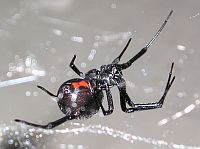
|
|
Western Black Widow - Latrodectus hesperus Western Black Widow - Latrodectus hesperus The Black Widow is a very interesting denizen of the Bay Area. It is one of the most notorious spiders in the United States. The term "Black Widow" is a general term that refers to the 3 species of Black Widow that inhabit the United States: the Western, Northern, and Southern Black Widows. The Northern and Southern Black Widows' distribution is limited to the eastern half of North America, so the species that is found in the San Francisco Bay Area is the Western Black Widow. Although different maturity stages may show different patterns, Black Widows are usually identified by their glossy black color, spindly legs, with a red hour-glass figure on the inside of their abdomens. They can be about the size of a half-dollar including the legs, and the body itself can be about as big as the tip of one's finger. They are hairless and have a round abdomen. The males are smaller and light-colored and do not bite. In spite of the popular myth, the female only rarely eats the male after mating. Black Widows gain their reputation not only because of their somewhat menacing appearance, but because they are frequently found near human habitation. They are often in nooks and crannies, under ledges, or piles of debris, in less frquented places, where webs can be easily strung. The Black Widow venom is quite toxic, and treatment for bites should be immediately sought, especially for small children. It is easy to avoid encounters by being careful where cobwebs are present and where humans don't regularly visit. They can easily be brushed out of the way with a broom or a large piece of cardboard. They are very timid and will do everything they can to avoid confrontation. |